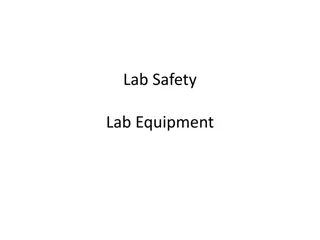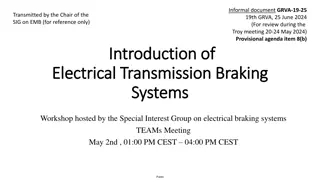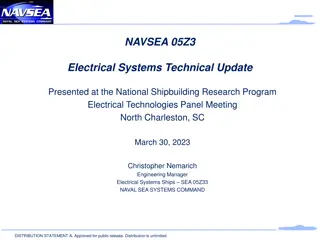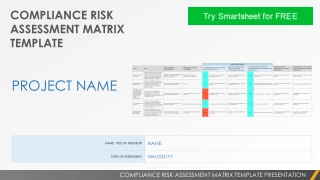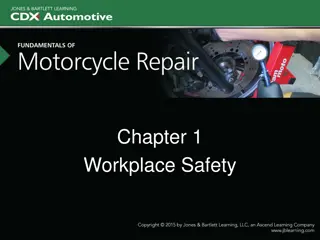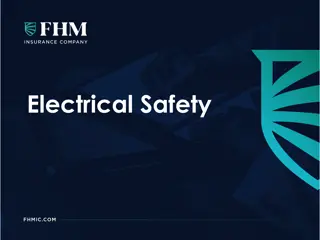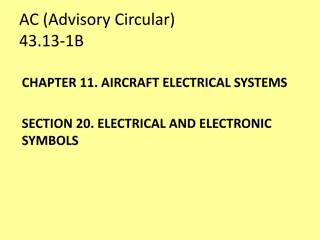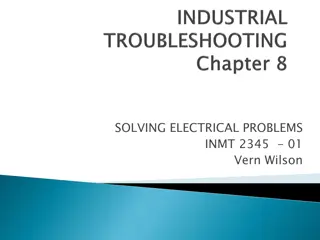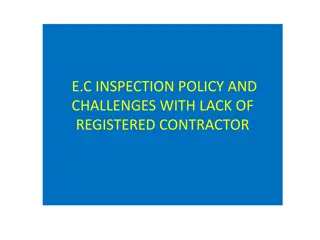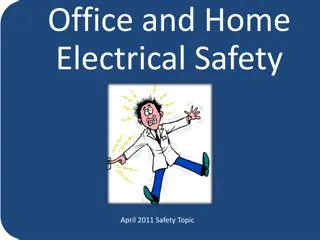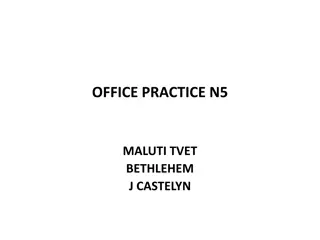Office Electrical Safety Tips for a Safe Workspace
Learn important office electrical safety tips to prevent hazards such as electrical shocks and fires. Inspect cords, avoid daisy chaining power strips, place cords properly, ensure enough outlets, and prevent overloading circuits. Prioritize the maintenance of a safe office environment for everyone's well-being.
Download Presentation

Please find below an Image/Link to download the presentation.
The content on the website is provided AS IS for your information and personal use only. It may not be sold, licensed, or shared on other websites without obtaining consent from the author. Download presentation by click this link. If you encounter any issues during the download, it is possible that the publisher has removed the file from their server.
E N D
Presentation Transcript
OFFICE ELECTRICAL SAFETY Environmental Energy Technologies Division (EETD) On the Job Training August 12, 2013 1
Office Electrical Hazards Electrical equipment used in office areas is potentially hazardous and can cause electrical shock or fires if improperly maintained. This brief training contains important electrical safety tips to follow for maintaining a safe office area. After reviewing this training, take a few minutes to inspect your office area using the electrical safety check list provided. Further information can also be found at the EETD Safety website: http://eetd- ehs.lbl.gov/content/electrical-safety 2
Are Cords and Plugs in Good Condition? Inspect cords regularly to ensure they are not damaged. Cord damage includes: cuts/tears of insulation, fraying, and exposed wiring. Adapters should not be used to convert a three-prong plug into a two prong. 3
Are Power Strips Daisy Chained? One power strip should not be plugged into another power strip. This is called daisy chaining . Daisy chaining can result in too many items plugged into an outlet causing an overloaded circuit. 4
Are Cords Properly Placed to Prevent Damage? Electrical cords should not be placed under floor mats or carpets. Do not use staples, tacks or nails to secure electrical cords. Electrical cords should not undergo severe bending, pressure or crimping. Do not place cords in aisles where they can become a trip hazard. 5
Are There Enough Electrical Outlets? Extension cords are permitted only for temporary uses. Extension cords should not be used as a means of reaching a far away outlet. If additional outlets are needed in an area, a Facilities electrician should be contacted to properly install. 6
Are Electrical Outlets Free of Overloading? Use of adapters to add plugs into an outlet should be avoided. Too many items plugged into a single circuit can cause circuit overload and tripping of the main breakers. In some instances, an overloaded circuit can overheat and cause a fire. 7
Do Your GFCIs Work Properly?Ground-Fault Circuit-Interrupters (GFCI s) GFCI s are to be used when using electrical equipment in a wet environment GFCI s are designed to detect any leakage of current in an electrical circuit before it can harm you GFCI s turn off or trip the circuit whenever the leakage is greater than 5/1000 of an ampere Test monthly using test button. Have something plugged into the circuit when testing. 8
Is All Equipment >50 Volts NRTL Approved? All electrical equipment greater than 50 volts must be approved by a Nationally Recognized Testing Laboratory (NRTL). This includes power strips and electrical cords. If NRTL approved equipment is not available, it must be inspected by the LBNL electrical inspectors prior to use. Typical NRTL logos to look for: 9
Is All Electrical Equipment in Good Condition? Electrical equipment must be maintained in good operating condition. Equipment must have all panels and covers securely affixed. Wall outlets must have the wall plate affixed. Look for signs of damage or overheating. If equipment is defective, take it out of service immediately! 10
Is Equipment Turned Off After Hours? Where possible, electrical equipment should be turned off during non-business hours. Area motion sensors should be used when feasible to prevent lights being left on at night. Use equipment with the EPA Energy Star logo affixed. 11
Is a Portable Space Heater in Use? Space heaters should be limited to small personal office areas only. If possible, have Facilities make temperature adjustments to your area. If a portable space heater is used, it must have: A grounded (three prong) plug. A maximum rating of 1500 watts or 13 amps. Auto tip-over shut-off feature. 36 clearance in front and 18 on sides and back. Do not plug heaters into extension cords or power strips. They must be plugged directly into a wall outlet. 12
Office Electrical Safety Self-Assessment Form A self-assessment form has been developed to assist in identifying electrical hazards. If you identify any hazards, let your supervisor know right away. Hazards must be promptly corrected. If needed, a Facilities Work Request should be submitted. ? ? ? ? ? ? ? ? ? ? ? ? ? ? ? ? ? ? ? ? EETD?Office?Electrical?Safety?Self-Assessment? ? Office?Number:? ? Assessor?Name:? ? EETD?Department:? ? Date:? ? Safety?Item? 1.? Are?electrical?cords?and?plugs?in?good?condition?? Answer? No ? if? outer? jacket? of? cord? damaged,? frayed? or? exposed? wiring.? 2.? Are?none?of?the?power?strips? daisy?chained ?together?? Answer? No ? if? one? power? strip? plugged? into? another? power? strip.? 3.? Are?electrical?cords?properly?placed?such?that?they?cannot?be?damaged?? Answer? No ? if? cords? under? carpets,? severe? bending? at? plug,? use? of? nails.? 4.? Are?there?enough?outlets?to?avoid?use?of?extension?cords?for?permanent? applications?? Answer? No ? if? extension? cords? are? in? permanent? use? 5.? Are?electrical?outlets?free?of?overloading?? Answer? No ? if? use? of? adapters? to? increase? the? number? of? plugs,? overheating? of? plugs,? tripping? of? breakers? 6.? ?Is? all?electrical?equipment?>50?volts?approved?by?a?National?Testing? Laboratory?? Answer? No ? if? no? UL,? ETL,? MET,? SA? label? on? equipment? 7.? ? Is?all?electrical?equipment?is?in?good?condition?? Answer? No ? if? missing? panels,? missing? wall? plates,? inoperable? switches,? etc.? 8.? Is?all?electrical?equipment?(including?computers)?turned?off?when?not?in? use?after?regular?office?hours??If? No ? indicate? equipment? type? in? comments? 9.? Is?the?office?temperature?comfortable?without?the?use?of?portable? heaters?or?air?conditioners??Answer? No ? if? portable? heaters? are? in? use? 10.? Are? area?lighting?motion?sensors?functioning?properly?? If? No ? indicate? type? of? problem? in? comments? ? ? ? ? ? ? ? ? ? ? ? ? ? ? ? ? ? ? ? ? ? ? ? ? ? ? ? ? ? ? ? ? ? ? ? ? ? ? ? ? ? ? ? ? ? ? ? ? ? ? ? ? ? ? ? ? ? ? ? ? ? ? ? ? ? ? ? ? ? ? ? ? ? ? ? ? ? ? ? ? ? ? ? ? ? ? ? ? ? ? ? ? ? ? ? ? ? ? ? ? ? Comments/Areas?for?Improvement? ? ? ? ? ? Rev? A,? 8/12/13,? R.? Scholtz? ? ? ? ? ? Yes? No? ? ? ? ? ? ? ? ? ? ? ? ? ? ? ? ? ? ? ? ? 13



